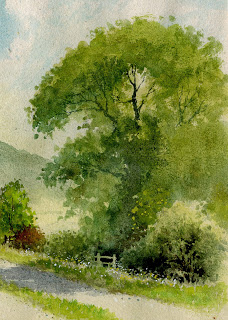As landscape artists we often see far too much in a scene for the good of our painting, and slavishly copy as much of the detail as we can. It really does pay to think about your need to include even what may seem to be an important part of the subject, and ask yourself if it does help to include the whole feature, or can you make subtle changes before that brush touches your paper?
In this view of Penyghent in Yorkshire, although I could see the entire mountain clearly, I felt that the profile was too stark: there was no mystery. So I introduced some lower cloud on the right to lose that strong curving edge of the peak by bringing down the shadow part of the cloud with French ultramarine and cadmium red over the yellow ochre of the mountainside. Then, by emphasising the shadowy shape of the lower part of the fell as it came out of the cloud, the overall shape of Penyghent was retained. The work was done on Saunders Waterford 140lb NOT paper.
I will be demonstrating at Patchings Art Festival on 14th, 15th and 16th July. The demonstrations will take place in the St Cuthberts Mill Marquee each morning. It will be great to return to Patchings after the two-year absence because of Covid. We will also have a small stand at the event, so do come along and see us.
Unfortunately my webinar with Painters On-line had to be cancelled because of my throat and chest infection which made it impossible for me to speak properly, but we are back on track now and the event is rescheduled for 11am on 4th August when I will be painting a Nile scene. I’m sorry for any inconvenience to anyone who booked. See details at Painters Online





